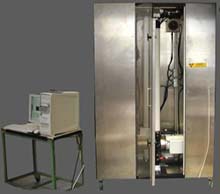
Lawrence Berkeley National Laboratory (Berkeley Lab) scientists have developed the world’s first x-ray computed tomography (CT) scanner capable of examining entire core samples at remote drilling sites. The portable device, which employs the same high-resolution imaging technology used to diagnose diseases, could help researchers determine how to best extract the vast quantities of natural gas hidden under the world’s oceans and permafrost.
The scanner images the distribution of gas hydrate

Three decades of research on men’s sexual arousal show patterns that clearly track sexual orientation — gay men overwhelmingly become sexually aroused by images of men and heterosexual men by images of women. In other words, men’s sexual arousal patterns seem obvious.
But a new Northwestern University study boosts the relatively limited research on women’s sexuality with a surprisingly different finding regarding women’s sexual arousal.
In contrast to men, both heterosexual and

Multi-National team of physicists include Weizmann Institute Scientists
Recent results of a joint experiment conducted by 460 physicists from 57 research institutions in 12 countries strongly indicate that the scientists have succeeded in reproducing matter as it first appeared in the universe; this matter is called the quark-gluon plasma. The experiment, called PHENIX and conducted at the Brookhaven National Laboratory on Long Island, New York, has brought together physicists from Br

Researchers at the University of Rochester have produced compelling evidence of how the hand of natural selection caused one species of fruit fly to split into two more than 2 million years ago. The study, appearing in today’s issue of Nature, answers one of evolutionary biologists’ most basic questions–how do species divide–by looking at the very DNA responsible for the division. Understanding why certain genes evolve the way they do during speciation can shed light on some of the least

University of Southampton scientists create a computer agent that aims to make life less complicated
A new computer agent that will work through users’ mobile phones and organise their business and social schedules, has been developed by scientists at the Department of Electronics and Computer Science (ECS) at the University of Southampton.
The agent is an example of how the next generation of World Wide Web will work. An artificial intelligence programme has been devised which a

Using the superior sensitivity of ESA’s X-ray observatory, XMM-Newton, a team of European astronomers has made the first direct measurement of a neutron star’s magnetic field.
The results provide deep insights into the extreme physics of neutron stars and reveal a new mystery yet to be solved about the end of this star’s life.
A neutron star is very dense celestial object that usually has something like the mass of our Sun packed into a tiny sphere only 20–30 km across. It is the p

At the Berlin synchrotron radiation source BESSY II, the largest magnetic anisotropy of a single molecule ever measured experimentally has been determined. The larger this anisotropy is, the better a…

LSU quantum researchers uncover hidden quantum behaviors within classical light, which could make quantum technologies robust. Understanding the boundary between classical and quantum physics has long been a central question…

One of the biggest mysteries in science – dark energy – doesn’t actually exist, according to researchers looking to solve the riddle of how the Universe is expanding. For the…

A team led by plant biotechnologist Prof Markus Schwarzländer from the University of Münster and biochemist Prof Bruce Morgan from Saarland University has developed new biosensors with which the ratio…

How deubiquitinases USP53 and USP54 cleave long polyubiquitin chains and how the former is linked to liver disease in children. Deubiquitinases (DUBs) are enzymes used by cells to trim protein…

Conceptual blueprint to analyze experimental catalyst data. Machine learning (ML) models have recently become popular in the field of heterogeneous catalyst design. The inherent complexity of the interactions between catalyst…

How simulations help manufacturing of modern displays. Modern materials must be recyclable and sustainable. Consumer electronics is no exception, with organic light-emitting diodes (OLEDs) taking over modern televisions and portable…

“Neurons that fire together, wire together” describes the neural plasticity seen in human brains, but neurons grown in a dish don’t seem to follow these rules. Neurons that are cultured…

The quest for sustainable energy solutions has been a major focus of scientific research for decades. Solar energy, a clean and renewable source, has emerged as a promising alternative to…

Pacific Northwest National Laboratory to contribute leadership to national effort in microelectronics design and development. Microelectronics run the modern world. Staying ahead of the development curve requires an investment that…

With a processing speed a billion times faster than nature, chip-based laser neuron could help advance AI tasks such as pattern recognition and sequence prediction. Researchers have developed a laser-based…

New technology could remotely identify various types of plastics, offering a valuable tool for future monitoring and analysis of oceanic plastic pollution. Researchers have developed a new hyperspectral Raman imaging…